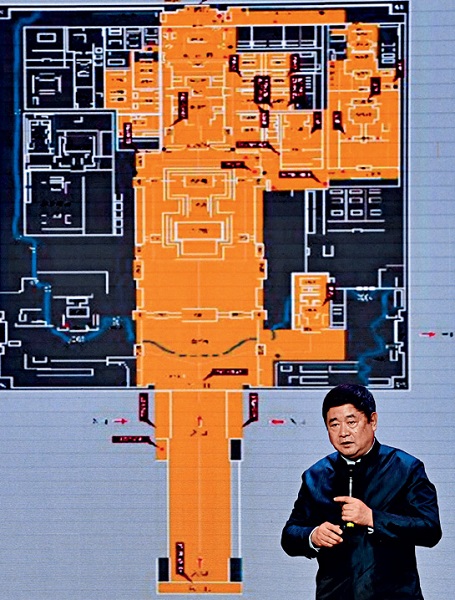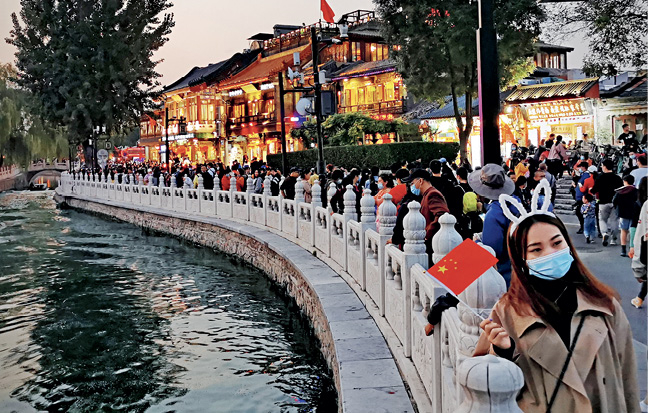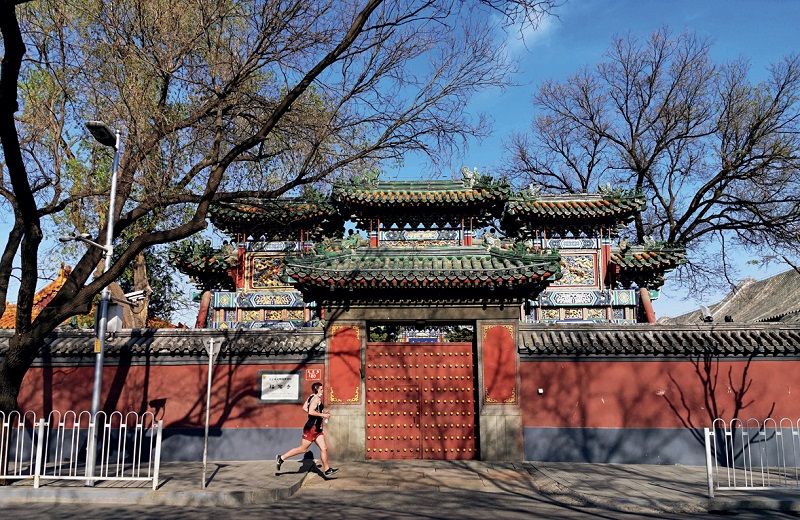The application of the Central Axis of Beijing as a World Heritage Site is also a process of improving the overall level of urban management and the living environment of the city.

Shan Jixiang introducing the protection and opening up process of the Central Axis at a cultural exchange activity on March 4, 2019.
Beijing's Central Axis is 7.8-kilometer long, stretching from the Bell Tower and Drum Tower in the north to Yongding Gate in the south. Being a combination of architectural complexes and urban space, the central area of the capital city has been shaped over a period of more than 700 years, and is a strong symbolic and ritualistic reflection of Eastern civilization.
The famous Chinese architect Liang Sicheng once said, in terms of overall layout, Beijing fully shows the traditional techniques of great Chinese national architecture and the wisdom of its urban planning. The city’s unique orderliness was born out of the establishment of this central axis. The application for the Central Axis to be included in the list of UNESCO World Heritage Sites was also proposed under the influence of Liang.
Living Heritage
Being built according to traditional Chinese planning concepts, the Central Axis is composed of rich cultural landscapes and symmetrical architectural patterns. It is not only the longest urban central axis in the world, but also the one with the richest connotation, incorporating traditional Chinese culture and ideologies.
The Central Axis embodies the city order and planning ideas from the Zhou Dynasty (1046-256 B.C.). It is also the core of urban composition and the backbone of the urban pattern. The streets and hutongs (alleyways) on both sides of the axis maintain a unique pattern, so that the entire old city forms a large area of symmetry, creating a sense of unique grandeur. In this way, the open urban space can be controlled, so that the city has a strong sense of wholeness, stability, and belonging.
Without understanding the Central Axis’ past, it is impossible to recognize its present or predict its future. It is not only a material carrier, but also a spiritual carrier. It embodies an important concept in Chinese civilization, namely, humans should live in harmony with nature, be kind to each other, and maintain inner peace. This is essential for the world to become a place of peaceful development and continuous progress. Being on the Central Axis, one can feel the spirit of the Chinese nation and the pursuit of peace and tranquility. It is also a living heritage, where the traditional Chinese concept of capital city planning continues to influence today’s cities.

Shichahai in Beijing is bustling with visitors at dusk on October 3, 2020.
Participation by All
After winning the bid to host the 2008 Olympic Games in July 2001, large-scale urban construction began in Beijing. One major concern of the Beijing Municipal Planning Commission, where I served as the director at the time, was that building large-scale complexes would affect the cultural landscape of Beijing’s Central Axis area and the Forbidden City. After much research, the planned large-scale complexes were placed outside the city’s Fourth Ring Road. Meanwhile, a number of urban development documents such as the Beijing Imperial City Conservation Planning and Beijing Olympic Park Overall Planning were formulated, and preliminary designs of dozens of key construction projects were reviewed. Moreover, a 14-square-kilometer world heritage buffer zone and cultural relic construction control zone were planned around the Forbidden City, Temple of Heaven, and other World Heritage Sites, and a large area of hutongs and quadrangle dwellings were protected. It is precisely because of these protective efforts that the recent application of the Central Axis as a World Heritage Site has been made possible.
The municipal Party committee and government of Beijing and local residents have done a lot of work to protect this Central Axis. For example, tall buildings that affected the integrity of the historical scenes of Di’anmenwai Street or the landscape between the Drum Tower and Jingshan Park were renovated. Tiantan Hospital was relocated to protect the Temple of Heaven as a whole. The Altar of the God of Agriculture was the place where the emperors of the Ming (1368-1644) and Qing (1644-1911) dynasties held the ceremony of offering sacrifices to Shennong and other gods. Once it was used as a school’s playground. In 2019, it was transformed into a display area for traditional farming culture, where visitors can participate in spring plowing, autumn harvest, and other agricultural activities. Archaeological discoveries at the Zhengyang Bridge outside Qianmen in 2021 were of great significance for the application of the World Heritage status and the protection and display of the Central Axis.
Beijing has also renovated many ancient buildings such as the Bell Tower and Drum Tower, Jingshan Park, and Zhengyang Gate. The World Heritage application also covered issues such as the old city management, the protection of famous historical sites and city culture, the improvement of people’s livelihood, and infrastructure construction. Relevant measures include the vacation of cultural heritage buildings, a responsible planning system, and block environmental governance.
The goal of the application is not only to get the Central Axis included on the World Heritage List, but more importantly, to promote the protection of the entire old city of Beijing, enhance Beijing’s historical and cultural value, promote Chinese civilization and cultural traditions, highlight the capital’s style, upgrade urban management, improve resident’s living environment, and promote the city’s overall sustainable development. Therefore, the protection, value display and environmental improvement of the Central Axis are matters that require the participation of the entire society. Even after the successful application, related work will continue.
The Ultimate Goal
From the protection of cultural relics to the protection in cultural heritage, this process reflects China’s concept changes in cultural protection in recent years.
Cultural relics protection focuses on the protection of cultural elements, while the protection of cultural heritage covers not only cultural elements, but also natural elements and cultural landscapes generated by humans and nature. The objects of cultural relics protection are mostly static, such as ancient sites, ancient tombs, the Great Wall and other objects that have lost their initial construction function, while cultural heritage protection also protects dynamic ones, such as traditional villages, ethnic villages, ancient water towns and other living environments.
Cultural relics protection focuses on the protection of ancient legacy, while cultural heritage protection also protects modern and contemporary heritage. The protection of cultural relics has expanded from ancient buildings to ancient building complexes and historical towns, while cultural heritage protection also protects cultural routes such as those for commodity trade, cultural exchanges, and human migration.
Cultural relics protection focuses on the protection of palaces, temples and monumental buildings, while the protection of cultural heritage also includes traditional residences, vernacular architecture, industrial heritage, and time-honored brands.
The protection of cultural relics only protects physical elements, while the protection of cultural heritage also protects intangible elements. Physical and intangible elements are an inseparable entity and must be protected as a whole.
To preserve or use, which is more important to cultural heritage? This question, which has been discussed by experts, scholars, governments and enterprises for some time, has been solved in the case of the Beijing Central Axis.
Our experience has shown that protection and development can complement each other. The Ming Dynasty City Wall Relics Park is a case in point. That section of city wall was abandoned and demolished during the late Qing Dynasty. Later a jumble of dwellings and small markets were built in the region. When the environment of Wangfujing business area was improved, the ruins of the imperial city wall and Dong’an Gate were discovered. After archaeological excavations, it was built into a heritage park, thus a strip of public green space in the urban core was established. From Ping’an Avenue to Chang’an Avenue, the total length is 2,800 meters, and the greening rate is 90 percent. A section of the imperial city wall has been restored in the north of the park according to the original location, raw materials, original craftsmanship, and original shape, and the Dong’an Gate site is on protective display. These moves not only protect the ruins, but also allow people to understand the history of the imperial city. Around the park, there are a number of cultural heritages such as the Forbidden City and the Grand Canal, as well as the Red Building of Peking University and the site of Sino-French University, forming a profound cultural space. The residents relocated for this conservation project have also had their living conditions improved. Such transformation and development not only protect cultural heritage and benefit urban construction, but also improve people’s wellbeing.
The real purpose of the protection and utilization of cultural heritage is to enable heritage to be inherited by future generations. It is the city’s goal to pass on the culture created by ancestors to future generations in a healthy, complete, and authentic manner.

A foreigner is jogging past the front of the Fuyou Temple next to the Forbidden City on April 13, 2020.
Enlivening the Central Axis
In January 2022, Professor LÜ Zhou, a contributor to the Beijing Central Axis inscription, was invited to hold the 2022 Beijing Central Axis Special Exhibition at the Beijing Dongcheng Cultural Development Research Institute, to promote the heritage value of the Central Axis to the public. In addition, a variety show named The Shape of Culture also filmed the Central Axis to tell the stories of the people living there.
The variety show selected 24 World Heritage sites or sites that are in the process of application, and brings the best parts of China’s cultural heritage to the audience. When shooting the Central Axis, experts were invited to walk from both sides and later meet up at the Tian'anmen Square, to experience its grandeur. After watching the show, and then walking along the Central Axis, whether on the streets and hutongs, or in the palaces and gardens, people will experience different feelings.
The application of the Beijing Central Axis as a World Heritage Site requires the active participation and joint efforts of all sectors of society. In fact, it is also a process of improving the overall level of urban management and the living environment of the city. By doing this work, it is hoped that more people will get to know the story of Beijing’s Central Axis, understand its value and support it to be listed as a World Heritage Site. 
SHAN JIXIANG is the director of the Palace Museum Research Institute and the president of the China Cultural Relics Academy.